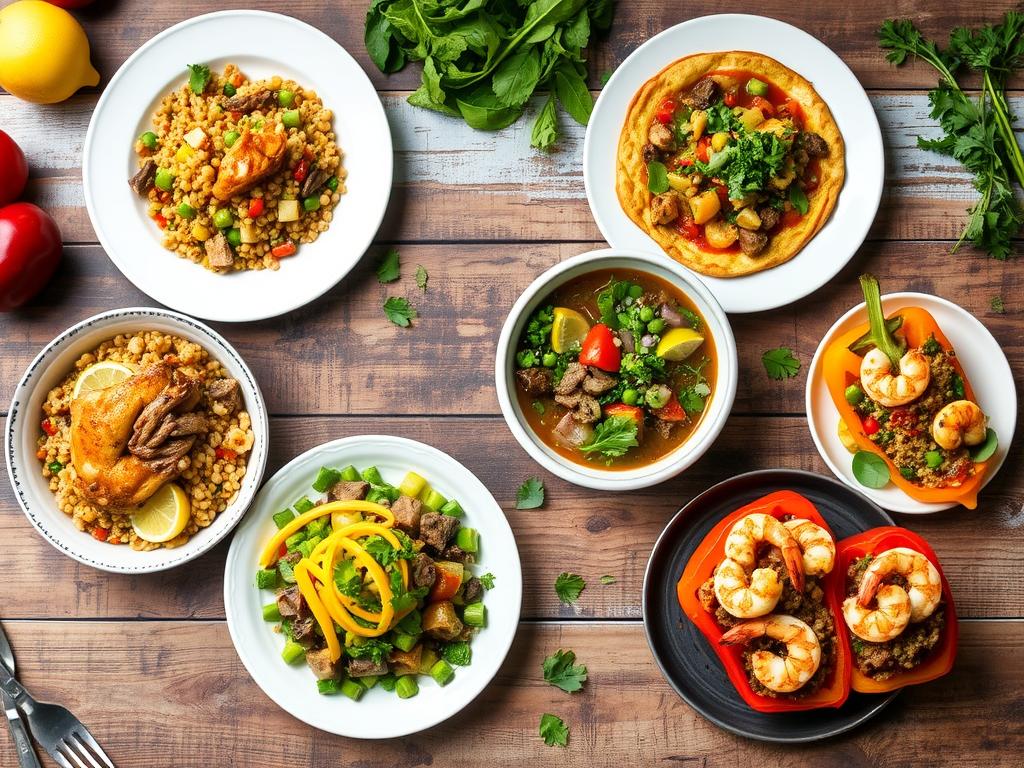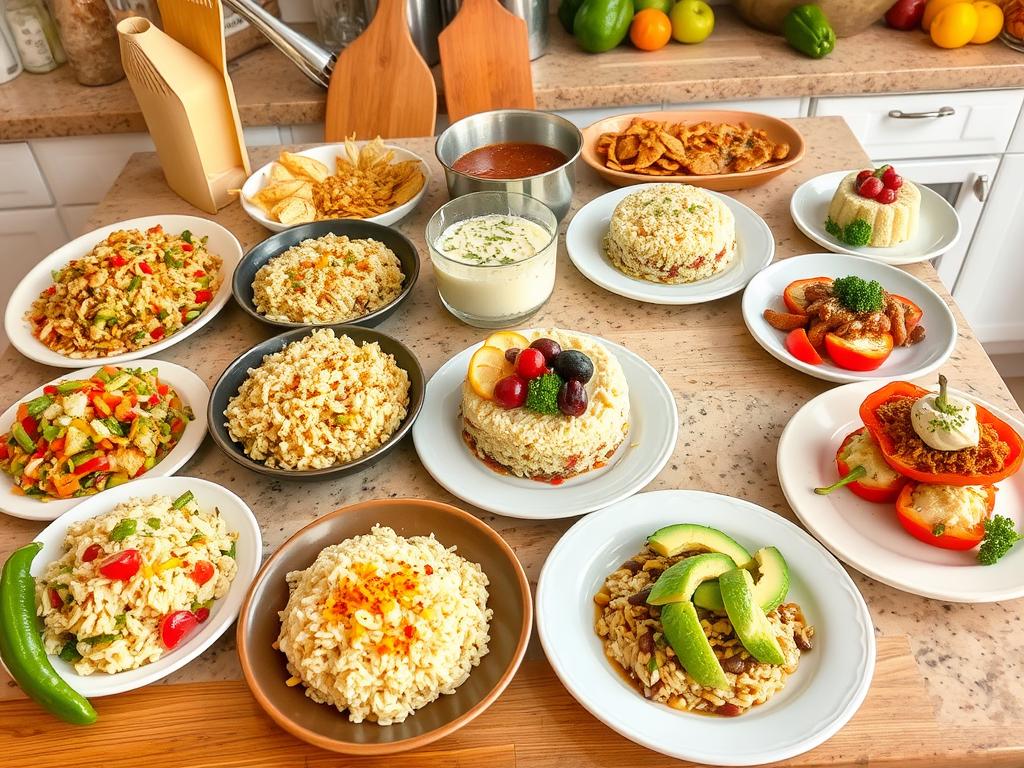Have you ever glanced into your fridge and faced an array of leftovers, battling the overwhelming question, “What can I do with this?” You’re not alone. Many of us find ourselves staring at chicken from two nights ago or wilted vegetables, feeling a mix of guilt and frustration. But instead of discarding these forgotten ingredients, imagine transforming them into a delightful meal that not only minimizes waste but sparks a moment of creativity in your cooking journey.
With approximately 40% of food produced in the U.S. going uneaten, embracing creative leftover recipe ideas can significantly contribute to reducing food waste while also reaping financial benefits. In this article, we’ll explore innovative leftover meal ideas that promise to bring vibrant life back to your kitchen!
Key Takeaways
- Repurposing leftovers reduces greenhouse gas emissions by cutting food waste.
- Planning meals strategically helps in transforming versatile ingredients into new dishes.
- Storing leftovers in airtight containers extends their freshness and shelf life.
- Creative use of leftovers saves on ingredient costs and energy in meal preparation.
- Efficiently utilizing leftovers reduces kitchen time during hectic weeks.
- Experimenting with different seasonings can rejuvenate the flavor of yesterday’s meals.
Transforming Leftover Vegetables into Delicious Dishes
Leftover vegetables often provide an untapped resource for creating delicious leftover dishes. With a little creativity, these remnants can transform into flavorful meals. Embracing the art of repurposing leftovers in cooking not only reduces food waste but enhances your culinary repertoire. Consider these innovative methods to make the most of your leftover veggies.
Whipping Up Vegetable Fritters
Vegetable fritters represent a scrumptious way to unify various leftover vegetables. By blending them with eggs and breadcrumbs, you create crisp, delectable snacks or a satisfying meal. This approach leverages many nutrient-rich options, elevating your diet while effectively utilizing what might otherwise go to waste.
Creating Hearty Vegetable Soups
Turn your leftover vegetables into hearty soups. Simply toss those forgotten veggies into a pot with some broth, allowing all the flavors to meld. Not only does this method salvage neglected produce, but it also ensures a nourishing and comforting meal that warms both the body and soul. For inspiration, you can check out cabbage recipes that illustrate how to use this versatile vegetable in various ways.
Mixing into Breakfast Scrambles
Start your day with a boost of nutrition by mixing leftover vegetables into breakfast scrambles. This delightful option adds unexpected flavors while fortifying your meal with essential vitamins and minerals. Engaging in such practices not only enhances your morning routine but also underscores the significance of incorporating fiber into your diet through smart use of leftovers.

Reinventing Proteins for New Meals
Leftover proteins present a golden opportunity for culinary creativity. By repurposing these ingredients, home cooks can create innovative leftover meal ideas that are both satisfying and resourceful. From shredded chicken tacos to hearty meatloaf, the possibilities are delicious and endless.
Shredding Chicken for Tacos
Transforming leftover roast chicken into tacos is a simple yet flavorful option. Shred the chicken and mix it with your favorite spices. Top the tacos with fresh vegetables and sauces for an added burst of flavor. This approach to cooking with leftover proteins not only makes use of what’s already in the fridge but also reduces waste significantly.
Crafting Meatloaf from Leftover Roast
Leftover roast can be reinvented as a classic meatloaf. Combine the meat with breadcrumbs, eggs, and seasoning for a delicious and filling dish. This method allows for the incorporation of various ingredients, enhancing both moisture and flavor. Enjoying meatloaf as a new meal is not only comforting but also an effective way to minimize food waste.
Blending into Smoothies for Extra Nutrition
Surprisingly, blending leftover chicken into smoothies can be a nutritious and innovative option. Adding protein to fruit and yogurt provides a unique twist, making for a high-protein snack. This creative use of leftover proteins boosts nutritional value while introducing new flavors, encouraging experimentation in the kitchen.

Repurposing leftover proteins leads to innovative dish creation and better meal planning. Incorporating these techniques not only saves money on grocery bills but also encourages a more sustainable approach to cooking. Discover more delicious leftover dishes and expand your culinary horizons by exploring ways to use everything efficiently.
Creative Uses for Stale Bread
Stale bread shouldn’t be seen as waste. Instead, it can spark some delicious homemade leftovers recipes! Embracing stale bread transformations allows creativity in the kitchen. Here are two delightful ways to give stale bread a new life.
Making Flavorful Croutons
Crafting croutons provides a satisfying crunch to salads and soups. Start by cubing the stale bread into bite-sized pieces. Toss these cubes with olive oil, garlic powder, and your favorite seasonings. Spread them on a baking sheet and bake until golden brown. These homemade croutons will elevate any dish while showcasing the beauty of creative bread recipes.
Preparing Bread Pudding for Dessert
Transforming stale bread into a rich bread pudding brings comfort to your dessert table. Soak the bread in a custard mixture of eggs, milk, sugar, and vanilla. Bake until it reaches a creamy consistency and golden top. This indulgent dessert demonstrates just how versatile stale bread can be, and it’s a great example of stale bread transformations that lead to happy taste buds. For further inspiration, check out various baking techniques from delicious homemade recipes.
Leftover Rice: A Culinary Canvas
Leftover rice serves as an exceptional base for a variety of dishes, showcasing its versatility in the kitchen. By embracing cooking with leftover rice, home cooks can whip up exciting meals that breathe new life into previously cooked rice.
Stir-Frying Unique Fried Rice Dishes
Fried rice emerges as a favorite for repurposing leftover rice. By combining it with vegetables and proteins, you can create a hearty dish infused with your favorite flavors. Common additions include soy sauce, garlic powder, or spices such as paprika and turmeric. A popular recipe includes:
- 2 cups of cooked rice
- 1 egg
- 1 cup of frozen mixed vegetables
- 2 tbsp soy sauce
- 1 tbsp sesame oil
This simple 5-Minute Fried Rice provides an ideal solution for busy days and showcases how leftover rice recipes can save time while maximizing flavor.
Crafting Rice Casseroles for Comfort Food
Another comforting option entails crafting rice casseroles. By layering meats, vegetables, and cheese, you can create a satisfying, one-dish meal that’s perfect for family dinners. These homestyle rice dishes allow you to mix flavors and textures, making use of all your leftover ingredients.
| Type of Rice | Best Use | Flavor Profile |
|---|---|---|
| White Rice | Fried Rice, Casseroles | Neutral, versatile |
| Brown Rice | Grain Bowls, Stir-Fries | Nutty, hearty |
| Jasmine Rice | Asian Dishes, Stir-Fries | Fragrant, sticky |
| Basmati Rice | Curry, Biryani | Aromatic, long grains |
| Sushi Rice | Sushi Rolls | Sticky, sweet |
Understanding different rice varieties opens up countless possibilities for leftover rice recipes. Using transforms and layering techniques can ensure that no rice goes to waste while creating delicious meals.

Elevating Leftover Pasta
Leftover pasta provides an excellent foundation for creating delicious and innovative pasta dishes. This versatile ingredient can be transformed into a variety of meals, ensuring that no pasta goes to waste. Two popular methods include turning pasta into a bake and forming a refreshing pasta salad, both ideal for quick meal ideas.
Turning Pasta into a Bake
One effective way to utilize leftover pasta is by creating a rich pasta bake. Combine the noodles with your favorite sauce, add some cheese, and toss in vegetables for a complete meal. Bake until golden and bubbly for a comforting dish that brings together flavors beautifully. This method not only makes mealtime exciting but also allows families to enjoy a hearty meal from their leftover pasta.
Forming Pasta Salad for Quick Meals
Another fantastic alternative is a pasta salad, which is perfect for quick meals either for lunch or dinner. This dish can be prepared in under 10 minutes by tossing cold leftover pasta with ingredients like olives, tomatoes, herbs, and a light dressing. Such quick meal ideas can invigorate your weekday lunches and are a great way to ensure you meet your weekly vegetable intake.
| Preparation Method | Cooking Time | Main Ingredients | Meal Type |
|---|---|---|---|
| Pasta Bake | 30 minutes | Pasta, sauce, cheese, vegetables | Dinner |
| Pasta Salad | 10 minutes | Cold pasta, olives, tomatoes, herbs, dressing | Lunch/Dinner |
Incorporating leftover pasta into your cooking can yield exciting and satisfying meals. These suggestions not only help to minimize waste but also allow for creative expression in the kitchen. With numerous leftover pasta recipes available, you can explore endless culinary possibilities.
Fun and Whimsical Ways to Use Leftover Sauces
Leftover sauces can add incredible depth and personality to a variety of dishes. These culinary remnants provide an opportunity for innovative cooking with sauces, transforming plain meals into delightful experiences. Exploring leftover sauce ideas can lead to new and exciting flavor combinations, making every meal feel unique.
Flavoring New Dishes with Leftover Sauces
Turning classic leftover sauces like marinara, barbecue, or pesto into flavorful meal enhancements is a smart way to reimagine your cooking. A splash of zesty sauce can elevate everyday dishes. Simply incorporate them into stir-fries, grain bowls, or casseroles to infuse a burst of flavor. Not only does this approach reduce waste, it also transforms mundane meals into memorable ones.
Drizzling on Pizza for an Extra Kick
Add an unexpected twist to your pizza night by drizzling leftover sauces on top. This simple technique can take ordinary toppings to gourmet levels. For example, pesto can create a refreshing flavor contrast, while barbecue sauce might add a smoky sweetness. Experimenting with various sauces can turn regular pizza into a culinary adventure.
| Type of Sauce | Best Uses |
|---|---|
| Marinara | Pasta, Stir-fries, Pizza |
| Barbecue | Grilled Meat, Pizza, Sandwiches |
| Pesto | Pasta, Sandwiches, Salads |
| Alfredo | Pasta Bakes, Creamy Sauces, Casseroles |
Tips for Storing and Reheating Leftovers
Properly managing leftovers is essential to maximizing both flavor and safety. Implementing effective leftover food storage tips can significantly prolong the life of your meals. For optimal freshness, it’s advisable to use clean, airtight containers made of food-grade plastic, ceramic, or glass. Glass containers are especially handy as they not only keep food fresh but allow for visibility, minimizing the risk of forgetting what’s inside. Moreover, if you’re planning to freeze your leftovers, consider using BPA-free plastic containers with snap-closed lids or zip-top bags that are clearly labeled with dates to ensure proper tracking.
Best Practices for Storage
To preserve your leftovers effectively, the USDA recommends refrigerating your meals within two hours of cooking. This helps prevent bacteria growth and ensures your food remains safe to eat. Generally, most leftovers can last in the fridge for about four days. However, some items, such as seafood, should be consumed within three days, while processed meats can last up to seven days. For a more extended storage option, utilizing a vacuum sealer is an excellent choice, especially for soups and sauces, as it removes air and prevents freezer burn.
Safely Reheating Leftovers
When it comes to reheating leftovers safely, it’s crucial to ensure even heat distribution to avoid foodborne illnesses. For example, to reheat pizza, set the oven to 400 degrees F for about 10 to 12 minutes. On the other hand, chicken should be reheated at approximately 325 degrees F. Cover dishes during reheating to maintain moisture and flavor. Incorporating these food preservation methods not only enhances the quality of your meals but also encourages a more sustainable approach to home cooking. Discover more inventive ways to utilize your leftovers, such as in recipes for delicious snacks or hearty dishes.











